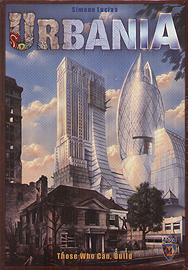 Urbania
Urbania is a game about Urban renewal as players attempt to rejuvenate the city back to its former glory.
Components:The components of this game are of good quality and the artwork, for the most part is excellent. The problem is that this game is TOO colourful making it difficult to distinguish between the undeveloped and developed sides of the buildings. yes you have symbols on the undeveloped side but as there is so much colour as the game progress it not a quick glance to work out what is what on the board.
If you have access to some cheap additional components then, like me, you can use something to place upon developed buildings to show that and it also helps to see which areas are nearing completion (one of the ending conditions)
GameplayOn each players turn they can take 2 actions, from the list below in any combination:
1. Draw cards:
You can draw two cards from the either the resource cards or the Project cards. The resource cards also have five face up cards available, if one is chosen from there it is immediately replaced. There is no hand limit in the game
2. Renew a building:
Each of the different building types can be renewed by playing a set of cards with a number Hard Hats matching the colour and number required. Once renewed the building provides a number of Victory points, marked on the building, and in some cases a free card draw. There are wild card Hard Hats (multicoloured), which on the cards can be used in place of any colour, on buildings the player can use any colour Hard Hard to renew but they must still be of one colour.
Renewed buildings must be orthogonally next to an already renewed building, the games starts with 5 random buildings in the centre already renewed. On the board is a value track showing the number of buildings of that type already built, the exception are the Blue Urban buildings.
If you play a card with both hard hats and coins at this point you can keep the card face up in front of you to use the coins later, either in this turn or a subsequent one to hire a specialist.
3. Hire a Specialist:
To hire a specialist you play cards with coins that match their colour, again there are wild card coins. The amount you pay for the specialist is based on where their Disc in on the specialist track, they all start at 1 but go up in value each time their are hired. Once hired they are placed face up in front of you, each specialist in front of you at the end of your turn earns you 1 VP for each building of their type currently renewed.
4. Play a project card:
To play a project card you pay 1VP for every 10VP you have, rounded down, so placing these early is cheaper. You place these face down in front of you and they scored at the end of the game. Players can have a maximum of three projects cards in play and once in play they can not be changed or removed.
Whilst a large amount of VP's can be gained from renewing buildings the project cards can reap a huge amount of points at the end if you match their criteria.
Each project card will score score for all of one type of building, One type or dual types of specialist, or by buildings renewed in a certain section of the city shown on the card.
End game is triggered when one district of the city has 2 or less undeveloped buildings or when 3 or more specialists cost 5 or more to hire.
ConclusionsI really enjoy playing this game, and though the colours are a bit garish it really doesn't stop the enjoyment of playing it. It is quite easy to teach and plays reliably in the time frame stated on the box, though expect your first game to be longer as you work through the rules. There is a good level of player interaction as you try and grab the specialists of other players to score them for yourself.
Excellent game, with plenty of replayability that, despite a few flaws, is worthy of a place in my collection

